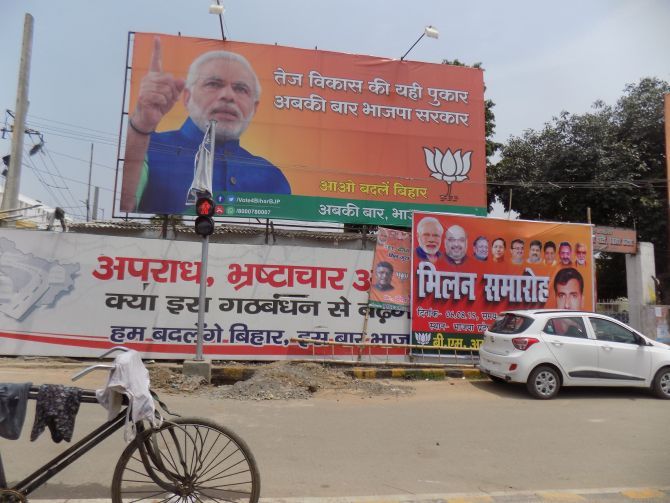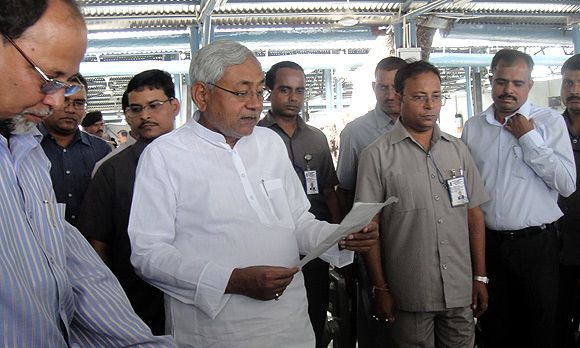 'The BJP has replaced huge portraits of the two BJP leaders from Gujarat with very small portraits of many leaders from Bihar. Much is being read into this changed tactic of hoardings and banners,' says Mohammad Sajjad.
'The BJP has replaced huge portraits of the two BJP leaders from Gujarat with very small portraits of many leaders from Bihar. Much is being read into this changed tactic of hoardings and banners,' says Mohammad Sajjad.
With two phases of the five phase Bihar assembly election completed and the results of 81 out of 243 seats sealed, many views about the prospects of the leading electoral alliances in Bihar -- the Bharatiya Janata Party-led National Democratic Alliance and the Mahagathbandhan led by the Janata Dal-United have started being aired.
Of these 81 seats, the NDA claims to be winning between 48 and 56 seats, whereas the Mahagathbandhan (the Grand Alliance) claims to have outsmarted the NDA significantly. In the three phases which will go to the polls, incumbent Chief Minister Nitish Kumar claims to be winning large numbers of seats.
The BJP started its election campaign with huge hoardings in Patna and other major cities of Bihar, displaying huge portraits of Prime Minister Narendra Modi and BJP President Amit Shah. This led Nitish Kumar to launch a campaign invoking the 'son of the soil' theory -- 'Bihari' versus 'Bahri' (the outsider). This slogan targeted even an important figure in the Bihar BJP, Sushil Modi, one of the likely chief ministerial candidates. Sushil Modi's father is said to have come from elsewhere to settle down in Bihar.
This BJP strategy whereby it contested the polls more on the prime minister's credibility and charisma and less on any other thing is alleged by political rivals and analysts to have been counterproductive.
Local BJP leaders aspiring to become chief minister (and their cliques within the BJP) are said to have lost interest in putting their best in the electoral campaign and strategies. The views of the BJP's opponents are getting acceptability also because the BJP has suddenly changed its strategy midway.
The party has now replaced huge portraits of the two BJP leaders from Gujarat with very small portraits of many leaders from Bihar. Much is being read into this changed tactic of hoardings and banners.
Talking to cross sections of the electorate, one often comes across a remark that this is an assembly election to elect a government run by a chief minister, rather than to elect a prime minister to run the Union government.
In the Lok Sabha election, Nitish Kumar and the JD-U won only 16% of the votes in Bihar.
Now the argument is Nitish Kumar cannot be expected to win less than that as his rating as incumbent as well as prospective chief minister is higher than anybody else. The Muslims (18%), Yadavas (13%) and Kurmis (4%) are said to be the Mahagathbandhan's staunchest support base, forming 35% of the total electorate.
The NDA's core support base is said to be the upper castes and banias, forming around 20%. Thus, the NDA is said to be lagging behind the Mahagathbandhan by about 15%.
This deficit, they say, is difficult for the NDA to make up. If the Paswans (Dusadhs -- the caste Ramvilas Paswan belongs to), and the Musahars (the caste Jitan Ram Manjhi belongs to) are said to be with the NDA, they argue that the Chamars and the Nonias among the Dalits are said to be with the Nitish Kumar-led alliance.
So far as the Ati Pichhrhas are concerned, both alliances claim that the significant chunk of these castes are with them. As Shyam Rajak, an articulate leader, is with the JD-U, it is claimed that his caste folk -- Dhobis (washermen) -- are with the Mahagathbandhan.
As Upendra Kushwaha was given an 'insignificant' 22 seats by the NDA, it is being argued, that his caste folk (the Koeris) no longer remain as staunchly with the NDA as they were expected to. The sting operation against Awadhesh Kushwaha, the minister in the Nitish Kumar cabinet on the eve of the second phase of the polls, is said to have antagonised the Koeris against the BJP.
RSS chief Mohan Bhagwat's statement that there would be a relook at the reservation policy created much alarm not only among the OBCs, but also among the SCs and STs. Some hitherto Ati Pichhrha castes have been given the status of STs by the Nitish Kumar government.
The prime minister, despite insistence and expectations, did not clarify his stand on Bhagwat's remarks. Lalu Yadav got a shot in the arm and he played it to the hilt through humour, sarcasm and his rhetoric of social mutiny against Brahminical supremacy.
Then again, the NDA gave its symbols to around 65 candidates from the upper castes. The fact that only 22 Yadavs will contest the election under the BJP symbol is helping Lalu keep his caste folk to his side.
Moreover, gossip that either Union Agriculture Minister Radhamohan Singh (the Rajput MP from Purvi Champaran, Motihari) or Skills Minister Rajiv Pratap Rudy (another Rajput and the MP from Saran) could be one of the candidates for chief minister may further alienate OBCs from the BJP.
Subsequently, by the time the second phase of polling on October 16 approached, reports emerged that Rajendra Singh (again a Rajput), who is contesting the election from Dinara in Rohtas, could be the chief ministerial candidate. Rajendra Singh has been one of the BJP's poll strategists in Jharkhand, and many workers from the Jharkhand BJP are seen in Dinara.
Bihar is known for long-standing rivalries between the Bhumihars and Rajputs. The Bhumihars may not be a happy lot seeing a Rajput become chief minister. There were whispers that the hardliner Nawada MP and Union Minister Giriraj Singh, a Bhumihar, could be a likely chief minister. Another senior BJP leader from the Bhumihar caste, Dr C P Thakur, has already been advised to join the Margdarshak Mandal (an euphemism used for leaders shunted out by Narendra Modi).
When Lalu attacked the Bihar BJP -- calling it a baraat (marriage party) without a dulaha (bridegroom) -- BJP spokesperson Syed Shahnawaz Husain floated the name of Prem Kumar, an Ati Pichhrha, who is contesting the election from Gaya, as the party's chief ministerial candidate.
By the time the polls are held in the Seemanchal region (eastern Bihar, which has a much higher concentration of Muslim voters), it is being surmised that the BJP might float Syed Shahnawaz Husain's name for chief minister. This vagueness, rather than paying off for the BJP, is said to be alienating OBC voters, with Lalu Yadav's campaign speaking of a return of 'Forward Raj' (an upper caste as chief minister) is also striking a chord with the OBCs.
During the Lok Sabha election, many OBC voters are said to have deserted Nitish Kumar because they thought that his campaign against Narendra Modi was adversely affecting a backward caste politician's prospects of winning India's top post.
A similar logic is said to be working against Modi now. Many OBC voters argue that why should the prime minister speak so much against Lalu Yadav and Nitish Kumar despite their caste folk having voted for Modi in 2014?
 Nitish Kumar's alliance with Lalu Yadav, it is argued, is working against the chief minister in two ways: a. Lalu's image is anti-development, and therefore anti-middle class, hence Nitish Kumar won't be able to carry out as much development as he did in the last ten years. b. The Yadavs could turn the Ati Pichhrhas against the Mahagathbandhan and in the BJP's favour.
Nitish Kumar's alliance with Lalu Yadav, it is argued, is working against the chief minister in two ways: a. Lalu's image is anti-development, and therefore anti-middle class, hence Nitish Kumar won't be able to carry out as much development as he did in the last ten years. b. The Yadavs could turn the Ati Pichhrhas against the Mahagathbandhan and in the BJP's favour.
Nitish Kumar thought of aligning with Lalu Yadav only after the JD-U's upper caste MLAs deserted him in May 2014 after Modi's victory. His alliance with Lalu Yadav is bringing in Yadav votes even as upper caste votes have shifted towards the BJP.
Secondly, the BJP's insistence in its campaigns that Nitish Kumar is becoming Lalu Yadav's 'puppet' and the RJD leader will have the remote control in a future JD-U-RJD government has cheered the Yadavs who believe their interests will be taken care of by Lalu Yadav. The Ati Pichhrhas, on the other hand, feel that so long as Nitish Kumar is there, they should not be scared of Yadav hegemony.
Another rationalisation currently popular is: If Nitish Kumar could let secularism prevail and contain the BJP's anti-Muslim stance despite being in alliance with the party during most of his tenure, then he could well be trusted to carry out development and good governance despite being in alliance with Lalu Yadav. Moreover, there are enough Yadavs in the middle class, hence they cannot afford anti-development politics any longer.
Mohammad Sajjad teaches Modern and Contemporary Indian History at Aligarh Muslim University and has written two books on Bihar: Muslim Politics in Bihar: Changing Contours (Routledge, 2014) and Contesting Colonialism and Separatism: Muslims of Muzaffarpur (Primus, 2014).










